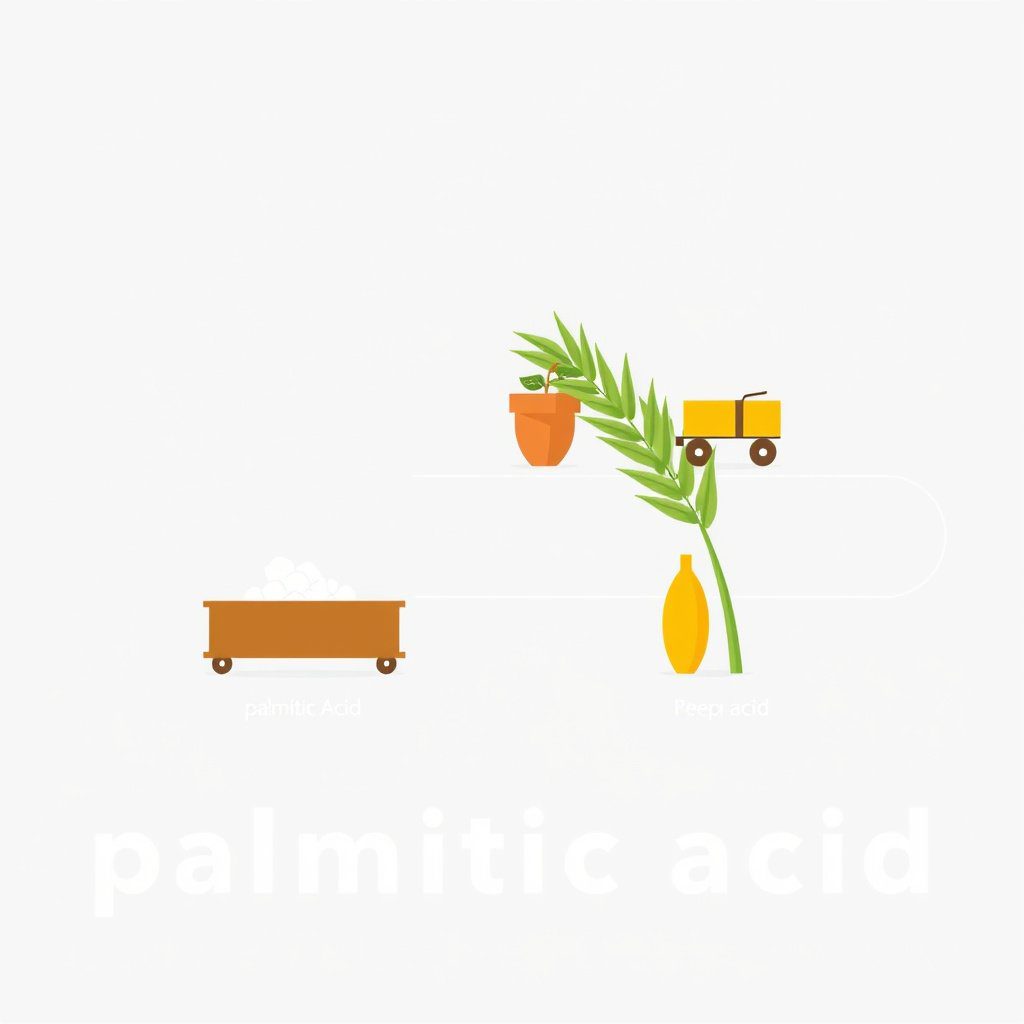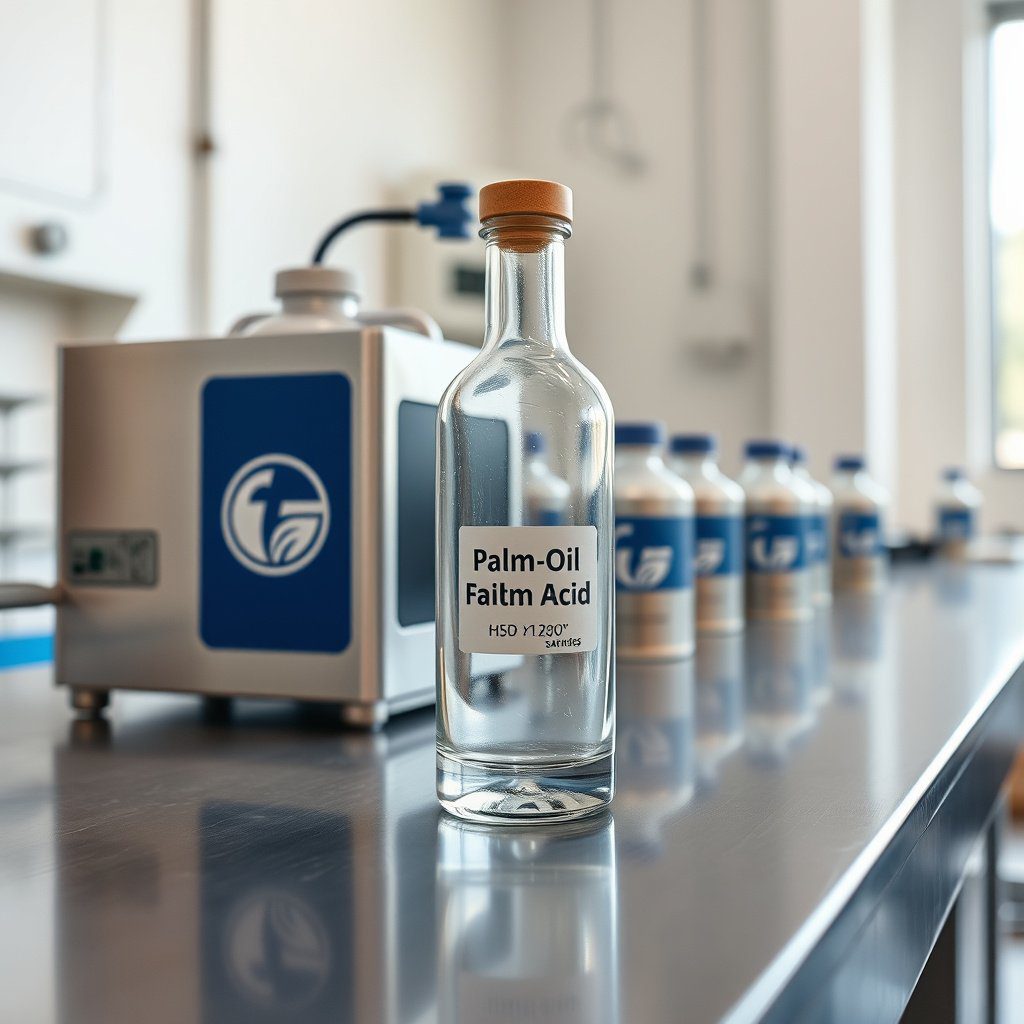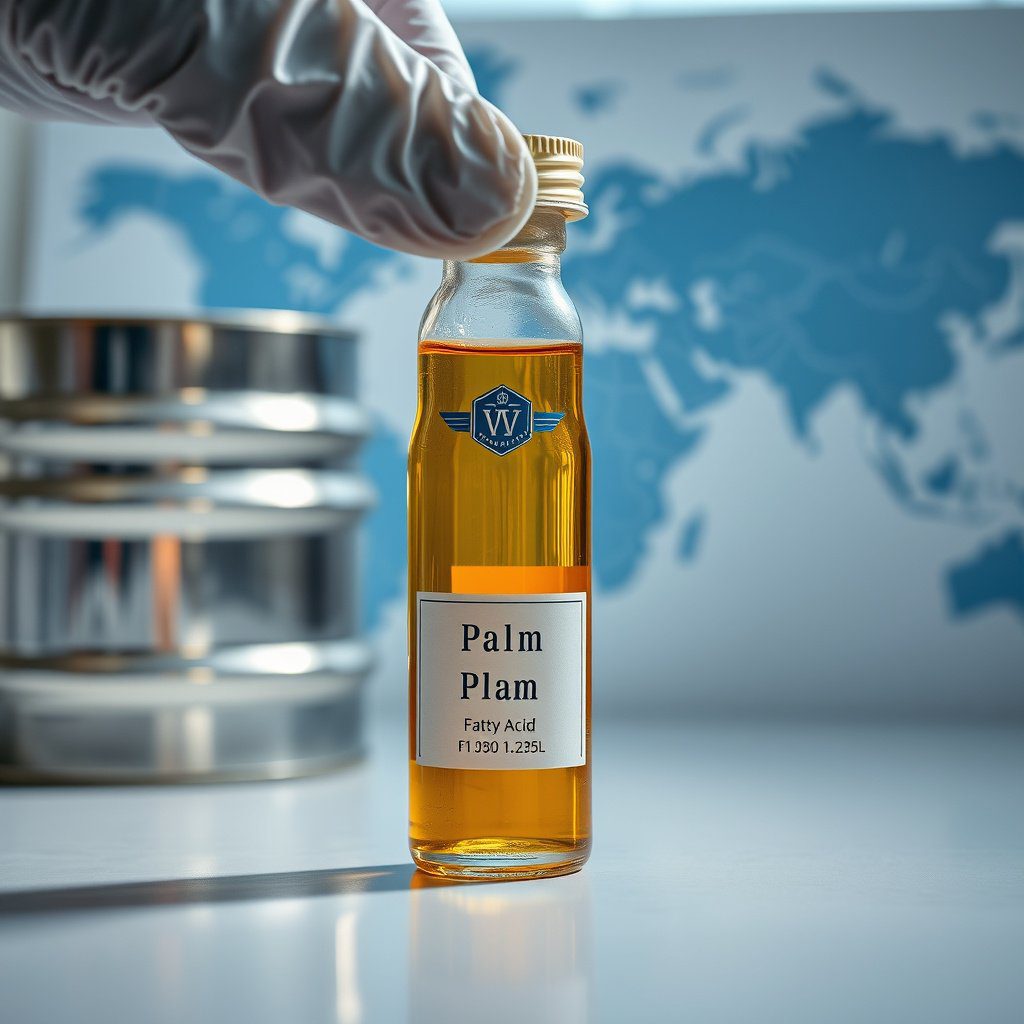Safe transportation of fatty acid derivatives demands a disciplined approach to packaging, labeling, documentation, and contingency planning.
For companies navigating the palmitic acid supply chain, the goal is not only to deliver material on time, but to ensure each shipment maintains integrity, complies with global standards, and protects people, the environment, and brand value.
Diplomata Commercial, with more than two decades in the chemical and oleochemical sectors, has built a global network and a track record of reliable, compliant deliveries across industries such as HPPC, pharma, industrial chemistry, animal nutrition, and food ingredients.
Our teams apply practical, field-tested methods to every link of the chain—from supplier qualification and inbound QC to outbound logistics and post-shipment documentation.
In the palmitic acid supply chain, safety hinges on end-to-end control, consistent communication, and a clear posture toward continuous improvement.
This guide distills the best practices we implement daily for customers seeking a supplier with global reach, robust quality systems, and proven transport safety.
Safety-Driven Transportation for the Palmitic Acid Supply Chain: Core Principles
Operational safety starts with risk-based packaging, deliberate handling, and explicit containment strategies.
When dealing with fatty acid derivatives, packaging decisions influence spill prevention, temperature stability, and contamination risk.
Our approach blends industry rules with practical experience from major ports and inland hubs to minimize disruptions and safeguard your people and assets.
Risk-Based Packaging and Handling
Packaging choices must match the chemical characteristics and transport mode.
We prioritize robust inner liners, compatible materials, and leak-prevention features that reduce exposure to heat, light, and moisture.
The goal is to prevent cross-contamination and ensure product integrity from plant gate to end user.
Organizations benefit from conducting a risk assessment early in the procurement cycle to determine container type, liner quality, and pallet configuration.
This reduces handling variability across carriers and geographies.
Practical steps include selecting packaging with validated compatibility, implementing dynamic inspection checklists, and aligning packing instructions with carrier requirements.
In real-world operations, a well-defined packaging plan correlates with fewer incidents, faster customs clearance, and smoother handoffs between multimodal legs.
The result is a more resilient supply chain and a measurable decrease in risk exposure.
- Choose packaging that minimizes exposure to air and moisture
- Use tamper-evident seals and batch-specific labeling
- Document packaging specs and test results for each lot
Containment, Transport Modes, and Segregation
Multimodal shipments demand careful mode selection—ocean, road, and rail each present different risk profiles.
Containment strategies consider temperature ranges, potential for agitation, and the possibility of off-gassing.
Segregation is essential when transporting other chemicals or products with incompatible chemistries.
Our approach emphasizes route planning, carrier qualification, and real-time visibility so that any deviation can be addressed quickly without compromising safety or quality.
In practice, we advocate for explicit carrier specifications, clear engineering controls during loading/unloading, and cross-functional communication between purchasing, logistics, and QA teams.
The payoff is a more predictable transit with fewer delays and a reduction in spill-related incidents, even when routes encounter congestion or weather-related events.
- Pre-qualified carriers with demonstrated safety records
- Defined segregation rules for adjacent cargo
- Real-time monitoring of temperature, pressure, and humidity as applicable
Labeling and Communication
Clear, consistent labeling drives safety and compliance.
Shipping documents, hazard communication, and emergency contact information should accompany every batch.
We emphasize standardized labeling formats, uniform SDS (Safety Data Sheets), and accessible digital records for rapid decision-making in emergencies.
Effective communication reduces response times and improves coordination with customers, port authorities, and insurers.
To maintain alignment across teams and borders, teams use standardized playbooks that translate complex technical details into actionable steps for field personnel.
This reduces interpretive errors and supports timely, accurate responses to inquiries from customers or authorities.
Strong labeling and transparent communication are as important as the packaging and containment decisions themselves.
- Hazard labeling aligned with GHS and local requirements
- Batch-level documentation: lot numbers, expiry, storage conditions
- Emergency contact information and SDS readily accessible
Regulatory Frameworks and Compliance for Palmitic Acid Shipping
Understanding and aligning with regulatory expectations is a cornerstone of safe, reliable shipping.
Global trade involves a mosaic of rules that cover classification, packaging, labeling, transport, and import/export controls.
Adherence isn’t a one-time task; it’s a continuous discipline that protects brands, reduces liability, and facilitates smoother cross-border movement.
Our clients benefit from a framework that integrates regulatory awareness with practical, day-to-day logistics operations.
Key Global Standards
Global standards provide a common language for safety and performance.
Compliance typically touches:.
- Hazard classification and labeling according to Globally Harmonized System (GHS)
- Packaging and transport guidelines under the IMDG Code for maritime shipments
- Road/rail transport rules under regional agreements and ADR equivalents
- Regulatory frameworks for chemical imports and exports within the EU, US, and other key markets
Organizations benefit from aligning with these standards while tailoring procedures to specific regional nuances.
Our experience across multiple jurisdictions helps ensure your palmitic acid shipments move with minimal friction, backed by documentation that stands up to audits and inspections.
To support ongoing compliance, we offer a combination of training, digital record-keeping, and supplier qualification programs that keep teams current with evolving requirements.
For reference, external resources such as the IMDG Code and general hazard communication guidelines provide a useful foundation for internal policy development.
Audit Readiness and Supplier Qualification
Audit readiness starts with a robust supplier qualification program.
This includes documented QA/QC procedures, batch traceability, and supplier risk scoring.
Regular internal and supplier audits validate process controls, container integrity, and the reliability of logistics partners.
A disciplined approach reduces non-conformances, improves corrective action timelines, and strengthens confidence with customers and regulators alike.
From our perspective, a well-structured supplier qualification program accelerates onboarding for new customers and new markets.
It also creates a feedback loop that sharpens risk controls and improves communication across the supply chain.
The result is a more predictable, compliant, and trustworthy palmitic acid supply chain.
- QA/QC protocols and batch record-keeping
- Supplier risk assessments and performance dashboards
- Audit trails that support traceability and accountability
Choosing a Palmitic Acid Supplier: What Truly Matters in a Global Partner
Selecting a supplier is a strategic decision that impacts reliability, cost, and risk exposure.
A strong partner offers not only product quality but also operational excellence, regulatory savvy, and a scalable distribution network.
In practice, the right partner becomes a value-added extension of your team—helping you navigate demand volatility, complex logistics, and evolving compliance landscapes.
Our approach blends industry specialization with a global footprint, delivering consistent outcomes for diverse customer programs.
Experience and Sector Specialization
Experience matters because it translates into the ability to anticipate challenges and pre-empt them with practical solutions.
A partner that has served HPPC, pharma, industrial chemistry, animal nutrition, and food ingredients brings a breadth of context that improves risk planning and logistics design.
In our experience, sector-specific knowledge informs packaging choices, handling instructions, and customer service models that align with quality and regulatory expectations.
With a partner like Diplomata Commercial, customers gain access to seasoned experts who understand both the science and the business of fatty acid products.
- Industry-focused teams with hands-on problem solving
- Tailored logistics strategies for complex supply chains
- Experience across global markets and regulatory environments
Traceability and Quality Assurance
Traceability is not a checkbox—it’s a strategic capability.
Effective traceability enables rapid investigations, accurate recall management if necessary, and continuous improvement.
Quality assurance goes beyond a certificate; it encompasses batch-level testing, verified supplier materials, and proactive QA collaboration with customers.
A trusted partner maintains robust documentation, performs regular QA sampling, and provides transparent access to batch records for each shipment.
When you can trace a batch from origin to delivery, you reduce risk and increase confidence in every link of the chain.
- Batch-level COA and QC testing results
- Transparent lot traceability from supplier to end user
- Collaborative QA with customers to resolve issues quickly
Logistics Capabilities and Global Footprint
Logistics breadth and flexibility are critical in a volatile market.
A global partner should offer multimodal capabilities, regional warehousing, cross-border compliance support, and reliable lead times.
The right partner aligns production schedules with customer demand, optimizes inventory positioning, and minimizes the risk of stockouts or overstock.
A well-connected logistics network also reduces transit times, enhances visibility, and strengthens disaster-response readiness—helping you maintain service levels even in disruption scenarios.
- Multimodal shipping options and regional hubs
- End-to-end visibility and proactive exception management
- Strategic geographic reach to support Brazil and international markets
Packaging, Labeling, and Documentation: Reducing Risk
Packaging, labeling, and documentation are the practical interfaces between regulatory compliance, product integrity, and customer satisfaction.
When these elements are handled consistently, the likelihood of incidents declines, and the flow of information improves across the supply chain.
Our guidance blends policy with field-tested practices, helping teams implement reliable standards that scale with your business needs.
Packaging Configurations and Rim Safety
Packaging configurations should balance protection, efficiency, and cost.
For fatty acid derivatives, this often involves robust drums or totes with inner liners, approved sealing systems, and arrangements that minimize vibration or temperature excursions during transit.
Considerations include headspace management, venting where applicable, and accommodating regional handling practices.
A well-designed packaging plan contributes to leak prevention, easier loading/unloading, and smoother port processing.
- Durable inner liners and compatible container materials
- Secure sealing methods and tamper-evident features
- Clear packing instructions tied to batch data
Labeling for Hazard Communication
Labeling should be unambiguous, machine-readable where feasible, and aligned with international conventions.
Critical elements include chemical name, CAS, batch/lot number, expiry (if applicable), storage conditions, and emergency handling notes.
Harmonizing labeling across regions reduces confusion, expedites inspection, and supports downstream operations, including warehouse management and quality control checks.
- GHS-compliant hazard statements and pictograms
- Batch-specific information and unique identifiers
- Emergency and handling instructions readily accessible
Shipping Documents You Need
Documentation is the nervous system of international trade.
Essential documents typically include commercial invoices, packing lists, bills of lading, COA (certificate of analysis), MSDS/SDS, and any transport-specific declarations.
A consistent documentation framework reduces customs delays, supports accurate tariff classification, and provides a transparent audit trail for customers and regulators.
- Commercial invoice, packing list, and bill of lading
- Certificate of Analysis (COA) and quality certificates
- Safety data sheets (SDS) and regulatory declarations
External references can be useful for broader context.
For example, the IMDG Code guidance helps shape best practices for maritime transport, while GHS standards support uniform labeling across markets.
Logistics and Temperature Management for Palm-Derived Fatty Acids
Effective logistics and temperature management are essential to maintaining product quality and operational reliability.
The right strategy combines appropriate storage conditions, careful choice of transport modes, and disciplined inventory management.
A partner with global reach and local expertise can adapt to route-specific constraints while preserving safety and efficiency across the journey from supplier to customer.
Temperature Control and Storage Conditions
Temperature considerations depend on the specific palmitic acid derivative and its physical state.
While some forms may be stable under ambient conditions, others require temperature controls to prevent phase separation, hydrolysis, or viscosity changes.
Implementing temperature monitoring, insulation, and appropriate active or passive cooling solutions helps maintain consistent quality.
Routine audits of storage facilities—both at origin and destination—further protect product integrity and customer satisfaction.
- Defined storage temperature ranges and monitoring
- Insulated packaging and temperature-controlled transport where needed
- Regular facility inspections and temperature documentation
Transportation Modes and Schedules
Choosing the right transport mode—road, ocean, or rail—depends on distance, volume, lead times, and risk tolerance.
Ocean shipping often offers economies of scale for bulk shipments, whereas road and rail can deliver speed and flexibility for regional or just-in-time needs.
Schedule optimization considers carrier reliability, port congestion patterns, and customs clearance cycles.
A well-planned logistics strategy reduces dwell times, improves throughput, and keeps downstream production calendars intact.
- Hybrid modal strategies for balance of cost and speed
- Carrier performance and on-time delivery targets
- Clear escalation paths for delays and disruptions
Inventory Control and Replenishment
Strategic inventory planning minimizes risk while supporting steady production.
Safety stock levels, reorder points, and lead time variability must be modeled to prevent shortages without incurring excessive carrying costs.
A data-driven approach, informed by demand signals, supplier reliability, and transportation performance, yields a lean yet resilient inventory posture.
This is particularly important for complex supply chains that span multiple regions and customers with varying risk profiles.
- Demand-driven safety stock and reorder points
- Supplier-based lead time and reliability analysis
- Integrated planning with procurement and logistics teams
Risk Management: Contingency Planning and Incident Response
Proactive risk management minimizes disruption impact and supports rapid recovery when events occur.
The goal is a prepared organization with defined teams, clear roles, and rehearsed response procedures.
A mature program combines preventive controls with responsive actions, ensuring the palmitic acid supply chain remains intact even under pressure.
This requires coordinated planning across suppliers, logistics partners, customers, and internal stakeholders.
What to Do in Transit Delays
Transit delays are an operational reality.
A tested plan includes alternate carriers, contingency routes, and predefined communication templates.
Early notification, transparent status updates, and rapid decision-making reduce downstream consequences, protect production lines, and preserve customer relationships.
A robust approach also involves scenario planning for weather events, port congestion, or regulatory holds.
- Alternate routing and carrier options
- Pre-approved escalation and decision protocols
- Real-time visibility and proactive customer communication
Crisis Communication and Stakeholder Coordination
In a disruption, clear, coordinated communication is essential.
A crisis-ready team distributes timely information to customers, suppliers, regulators, and internal leadership.
Consistent updates and accurate expectations help maintain trust and minimize reputational impact.
The best programs combine predefined messaging with flexibility to customize details for different audiences while preserving confidentiality and safety considerations.
- Pre-scripted messages for common disruption scenarios
- Single point of contact for customers and regulators
- Post-incident reviews to identify learning and improvements
Sustainability, Traceability, and Ethics in the Palmitic Acid Supply Chain
Transparency, responsible sourcing, and environmental stewardship are increasingly central to logistics and procurement.
A modern palmitic acid supply chain integrates sustainability into every step—from origin sourcing to final delivery.
This approach aligns with customer expectations, regulatory trends, and social responsibility standards.
By embedding traceability and ethical sourcing into the DNA of operations, companies strengthen brand trust, reduce risk, and unlock long-term value for stakeholders.
End-to-End Traceability Systems
Traceability goes beyond batch numbers; it encompasses the full journey of a product, including origin, processing steps, storage conditions, transport legs, and final disposition.
Digital traceability platforms enable real-time visibility, faster investigations, and granular data for quality assurance and compliance reporting.
When customers can access a transparent history for each shipment, confidence grows, audits become smoother, and supplier relationships deepen.
- Batch-level traceability from supplier to customer
- Digital records with tamper-evident audit trails
- Integration with customers’ ERP and QA systems
Sustainable Sourcing and Certification
Responsible sourcing is increasingly tied to certifications and third-party audits.
Certifications relating to palm-derived products, environmental stewardship, and social responsibility help demonstrate commitment to sustainable practices.
While not every certificate applies to every shipment, pursuing credible certifications signals long-term viability and ethical leadership.
Partnerships with suppliers that emphasize sustainable practices contribute to corporate resilience and stakeholder trust.
- Third-party sustainability certifications (e.g., RSPO-type frameworks)
- Renewable energy and waste reduction programs in manufacturing and logistics
- Ethical labor practices and supply chain governance
For reference, stakeholders often consult independent sustainability frameworks and industry guidelines to benchmark progress and communicate impact to customers.
Integrating sustainability with day-to-day operations creates measurable value across procurement, logistics, and compliance teams.
Próximos Passos Estratégicos
To optimize your palmitic acid supply chain with a partner that combines deep chemical expertise, global logistics, and practical compliance, start with a structured conversation about your current needs, risk tolerance, and growth plans.
Diplomata Commercial offers a consultative engagement model that aligns product quality, safety, and delivery performance with your business objectives.
We bring seasoned experts, cross-border capabilities, and a commitment to sustainable, scalable solutions that empower your operations today and into the future.
If you’re ready to explore how a trusted supplier can strengthen your safety posture and bottom line, contact Diplomata Commercial to schedule a strategic discussion.
For broader reading, you may also review authoritative resources on maritime safety and hazard communication, such as the IMO and the OSHA standards, which underpin best practices in chemical shipping and worker safety.
Frequently Asked Questions
What are the essential packaging and labeling practices for a safe palmitic acid supply chain?
A safe palmitic acid supply chain starts with risk-based packaging tailored to fatty acid properties, including robust inner liners and leak-prevention features. Labels should clearly communicate hazards, batch/lot numbers, and required transport and safety documentation to support global compliance.
How does packaging impact temperature stability and contamination risk in palmitic acid transport?
Packaging choices directly influence temperature stability and contamination risk during transit. Using compatible materials and secondary containment minimizes heat exposure, moisture ingress, and cross-contamination from plant gate to end user.
Why is supplier qualification critical in ensuring a safe palmitic acid supply chain?
Supplier qualification ensures consistent quality and safety across the palmitic acid supply chain. Through audits, inbound QC, and alignment to global standards, buyers reduce risk and improve delivery reliability.
What documentation and contingency planning steps support safe palmitic acid shipping?
Accurate certificates, MSDS, and complete transport declarations support regulatory compliance for palmitic acid shipments. Predefined contingency plans for spills, delays, and disruptions help protect people, the environment, and brand value.
What strategies reduce spill risk in the transport of fatty acid derivatives like palmitic acid?
Implement leak-prevention packaging, secondary containment, and deliberate handling procedures tailored to fatty acid derivatives. Training and field-tested containment strategies at key ports and hubs help safeguard personnel and assets.
What common challenges do global palmitic acid logistics face at ports and inland hubs?
Global palmitic acid logistics must navigate regulatory differences, port congestion, and documentation gaps. Proactive communication and standardized procedures help mitigate disruptions across the supply chain.
How does end-to-end control and communication strengthen safety in the palmitic acid supply chain?
End-to-end control ensures visibility across supplier qualification, inbound QC, outbound logistics, and post-shipment documentation. Clear, ongoing communication and a culture of continuous improvement protect product integrity and people.
Why should a buyer choose a supplier with field-tested methods for palmitic acid transport safety?
Field-tested methods demonstrate practical experience across ports, inland hubs, and major industries, reducing unforeseen risks. A supplier with global reach and robust quality systems delivers safer, more reliable palmitic acid shipments.





